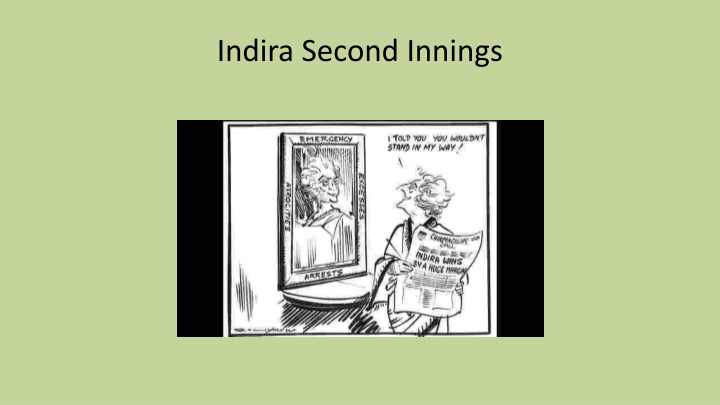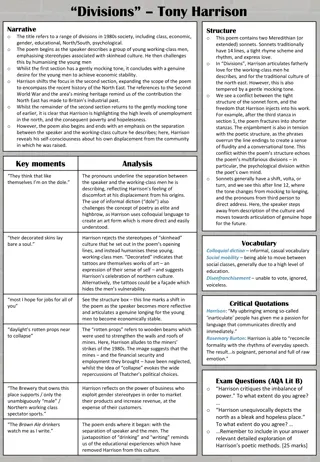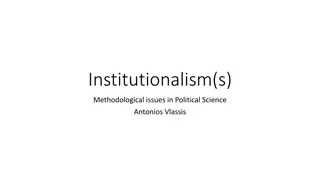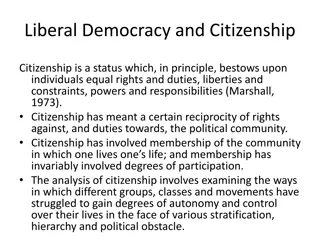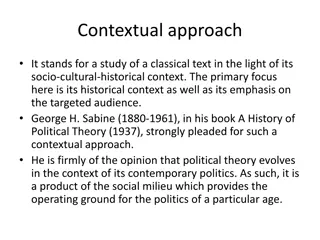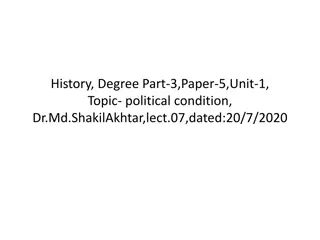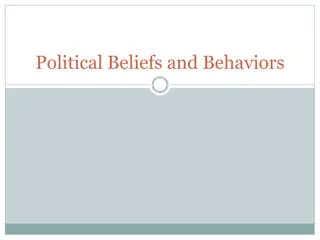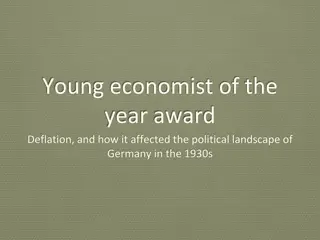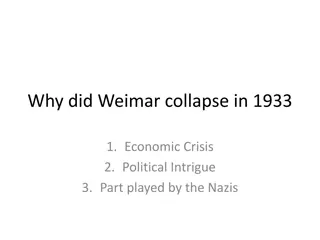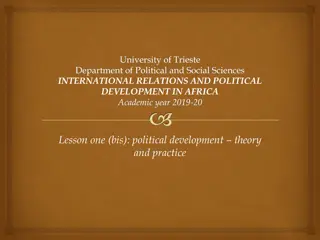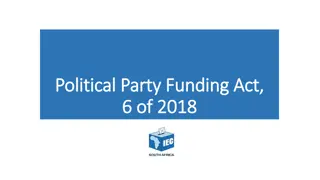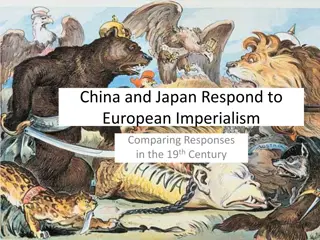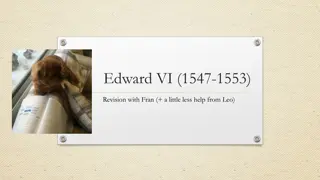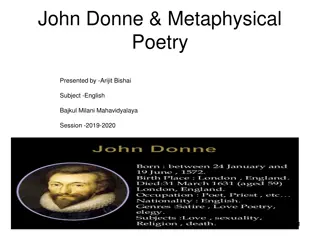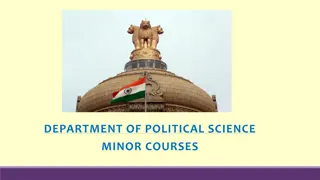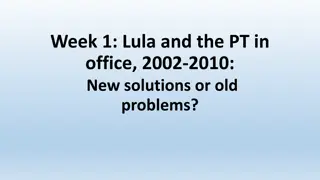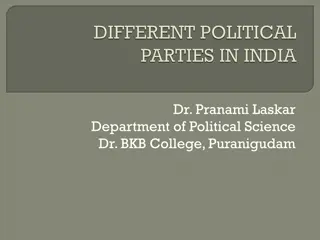Political Turmoil in 1980s India
The political landscape in 1980s India was marked by significant events such as the rise of communal tensions in Kashmir, the emergence of Sikh separatism in Punjab, and the assassination of Prime Minister Indira Gandhi. These events led to a period of turmoil, including Operation Blue Star and anti-Sikh pogroms. The actions and strategies of political leaders further fueled unrest and division within the country, shaping the course of Indian politics in subsequent years.
Download Presentation

Please find below an Image/Link to download the presentation.
The content on the website is provided AS IS for your information and personal use only. It may not be sold, licensed, or shared on other websites without obtaining consent from the author.If you encounter any issues during the download, it is possible that the publisher has removed the file from their server.
You are allowed to download the files provided on this website for personal or commercial use, subject to the condition that they are used lawfully. All files are the property of their respective owners.
The content on the website is provided AS IS for your information and personal use only. It may not be sold, licensed, or shared on other websites without obtaining consent from the author.
E N D
Presentation Transcript
Second Innings Sanjay death Mrs. Gandhi s reliance on family increases. Rajiv Gandhi pushed into politics Populism and Autocracy States Rights and States Pride : NTR in Andhra Pradesh, AASU in Assam, and Separatism in PUNJAB Populist Communalism in KASHMIR
Kashmir BEGIN COMMUNALIZING the situation in Kashmir. In 1983 Farooq Abdullah, Sheikh Abdullah s son joins an opposition coalition Mrs Gandhi, in her campaign, painted him as a secessionist. BLATANTLY appealed to HINDUS of Jammu, and invoked FEAR of VALLEY MUSLIMS. Farooq won, but this event first created RELIGIOUS polarization in Kashmir Even separatists , TILL THAT TIME had spoken of need to secede because they were KASHMIRI and included Hindu Kashmiris in their description of Kashmir. This was to change soon after. 1984, political machinations by Mrs. Gandhi ensure that Farooq is removed as Chief Ministers. Kashmiris begin to believe that Delhi will never let them exercise their own political will within India. Leads to support for separatism.
PUNJAB and Sikhism SIKHISM: 15-16thC, founder Guru NANAK Given present form by Guru Gobind 17th C 18-19th C RANJIT SINGH Sikh kingdom 19th C reformers, SINGH SABHAS Early 20thC AKALI DAL 1947 Tara Singh demand for separate Sikh homeland. Dismissed 1966 Punjab as Linguistic State
Political Context of 1980s Akali Dal vs INC main rivalry Rough parallels to Sikh and Hindu pop. Green Revolution makes many Sikh middle peasants richer Indira Gandhi tries to break the hold of Akalis by promoting an extremist Sikh religious leader Jarnail Singh BHINDRANWALE
Out of Control in Punjab Political Assassinations Civilian Massacres Targeted Killings police and military personnel Take over and fortify the Golden Temple in Amritsar
Operation Blue Star and Assassination Army Called in Parts of temple destroyed in seige (use of mortars deemed necessary) Bhindranwale and followers killed Anger at desecration Mrs. Gandhi assassinated by Sikh bodyguards in 1984 Anti Sikh pogroms in in Delhi and other cities
Assessing Mrs. Gandhi Punjab and Kashmir reveal the disastrous results of a short term focus on popularity and winning elections by any means necessary A widespread erosion of the idealism that had characterized earlier years of politics was a singular product of Indira Gandhi s contribution to Indian politics This included encouraging corruption and criminality. Most politicians under Nehru would not think of personally profiting from political office, nepotism perhaps, but corruption was a fact of life under Indira Gandhi. Similarly with using violence, Nehru NEVER condoned it but Indira simply treated it as another means by which politics carried out. No commitment to economic planning other than sops to important constituencies in election years DO READ KRISHNA RAJ s ASSESSMENT. Guha, pg. 567-68.
Dynasty Established: The Other Son RAJIV GANDHI Elections following assassination lead to LARGEST EVER MANDATE Seen as fresh, new, honest, and NOT a traditional politician. Immense hopes, quickly belied!! Began well, quick accords with regionalists, in ASSAM, MIZORAM, and PUNJAB. Promised to recreate democracy within the INC
Rajivs Populism INC Reforms don t work out BABRI MASJID Shah Bano Case Then, BOFORS, Corruption Accusations VP Singh
Economic Liberalization Starts under Rajiv and VP Singh is his finance minister But after promising start, does not deliver in the dismantling of the license-raj PV Narasimha Rao 1991 crisis Manmohan Singh as Finance Minister BJP ambivalence Swadeshi on the one hand and Pro- Business on the other
CONTEXT Soviet Union collapse, valuable trade partner. India e.g. barter foodstuff for oil with USSR for a long time. NO loss of foreign exchange. IDEOLOGICALLY big blow to planned economics, state control of economies, and immense and perhaps unjustifiable faith in the market replace that. Attack from international economists, often expatriate Indian = State controls of the economy had led to stagnation, lack of competition, lack of growth. Jagdish BHAGWATI (now at Columbia University) was the major spokesmen for a NEW IDEOLOGY asking for removal of state control, free market and free enterprise, opening up of the barriers to international trade , as the only solutions. Some change needed, no doubt, and governments, since Rajiv era, tempered by DEMOCRATIC politics, introduced market oriented reforms, slowly.
Questions About Growth Growth for WHOM? HOW will it solve the problem of illiteracy, inequality, etc. Would it simply make the rich even richer? Liberalization, market forces work towards growth, but as Edward Abbey said, growth for the sake of growth is the ideology of the cancer cell!! Rather than just growth need to focus on what KIND of growth, to ask WHO grows and who doesn t? Ultimately though it come back to the central paradox. How will can one balance democracy with economic growth? WHY is this an issue in India? Paradox of a democracy, competing demands on state from different interests, often locally and parochially organized, at a time when there are not enough resources.
Economy Achievements and Failures: Nehru to Rajiv END FAMINE LOW FOOD AVAILABILITY: 35% LIVE BELOW POVERTY LINE = ONE SQUARE MEAL A DAY STILL WELL BELOW CHINA DALIT, POOR, WOMEN OFTEN DENIED RIGHT TO VOTE WIDESPREAD ILLITERACY, 50% ADULT LITERACY RATE LARGE NUMBERS LEFT OUT OF DEVELOPMENTAL PROCESS LACK OF BASIC EDUCATION, UNIVERSAL HEALTH CARE, ACCESS TO CLEAN WATER REGIONAL IMBALANCES SOME OF THE WORLD S POOREST LIFE EXPECTANCE 30>60 DEMOCRACY LARGE SCIENTIFIC COMMUNITY INDUSTRIAL INFRASTRUCTURE NUCLEAR & SPACE PROGRAMS POCKETS OF ECONOMIC GROWTH WORLD S LARGEST MIDDLE CLASS
